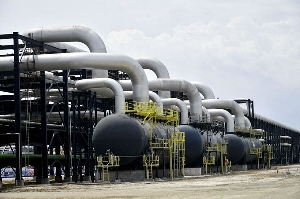Opinions of Monday, 18 January 2010
Columnist: GNA
Using cotton to alleviate poverty in Northern Ghana
A GNA Feature by Paul Achonga Kwode
Tamale, Jan. 15 GNA - Cotton is a major cash crop cultivated in most parts of the globe including Ghana. It is a soft, stable fibre shrub native to tropical and sub-tropical regions around the world including the Americas, India and Africa. The cultivation of cotton started seven thousand years ago, in the Indus Valley, a place today inhabited by North-western India and Eastern Pakistan. The largest producers of cotton in 2009 were China and India with annual production of approximately 34 million and 24 million bales respectively. Textile industries in these two countries consume up to 80% of what they produce.
Raw cotton exports are from the United States and Africa. Sales are $4.9 billion and $2.1 billion respectively. The total international trade in cotton is estimated at $12 billion. Since 1980, Africa's share of the cotton trade has doubled. In the case of Africa, exports of raw cotton are occasioned by an absence of any significant domestic textile industries to add value to cotton grown by numerous small farm holders and the need to earn foreign exchange.
The fibre is spun into yarn or thread and used in the textile industry. Cotton seed is a source of quality edible oil. A by-product after the extraction of oil is a cake that is excellent feed for livestock.
THE COTTON INDUSTRY AND GHANA COTTON COMPANY LIMITED
As a form of employment, farmers mostly in the three Northern Regions engage in the production of the crop to increase their incomes. Large scale cotton production by the then Cotton Development Board of the Ministry of Agriculture started in 1968,long after many other countries in West Africa (Mali, Burkina Faso, Benin, Togo and La Cote d'Ivoire) had done so.
Successes achieved in these countries in terms of production continue to serve as benchmarks for Ghana. For instance, while Ghana only managed to produce 36,000 metric tons of seed cotton in 2006/7, Burkina Faso produced a colossal 700,000 metric tons. The fortunes of Ghana Cotton Company Limited (GCCL) have drastically declined over the years due to both internal and external factors. Some of these include little attention paid by government to the sector; the absence of subsidies to cotton farmers; high interest rates on loans for agriculture; poor loan recovery from farmers; mismanagement and above all, a bearish world market price for the commodity.
The effect is that the booming textile industry in the past is now a pale shadow of itself. The few firms still in operation now have to depend heavily on raw material imports. Cheap imported textile products price out those of local firms on the market.
If Ghana were to reverse the situation, then Ghana Cotton Company Limited has to be supported to deliver. As it stands now, the Company is able to attract only a few out-growers. Inadequate support to these farmers coupled with untimely delivery negatively affect yields. The Company's broken down fleet of tractors and haulage trucks compounds the problem. In spite of the fact that Company plans to cultivate 30,000 hectares of cotton come 2011, this may not succeed if support does not come by way of a re-engineering of the Company.
THE WAY FORWARD
The way forward has been proposed by many a study already undertaken by Consultants. The problem remains mastering the courage to religiously implement suggested recommendations.
Some of the recommendations include the formation of cotton producer groups; development of animal traction; pre-financing farmers and subsidies on agricultural inputs to reduce cost of production. Any medium term strategies should include the introduction of a crop rotation system with food crops that would help the restoration of soil fertility.
As a long term strategy, it is prudent to work towards the establishment of an autonomous sustainable revolving fund that would support the activities of cotton farmers.
In Tanzania for instance, the Tanzania Gatsby Trust (TGT) has launched a special programme to increase cotton production to 1,500,000 bales by the year 2015 from the current 700,000 bales. It has set aside $7.2 million for the period 2008 to 2010.
Major policy decisions including the adoption of Genetically Modified (GM) technologies and drip irrigation systems to improve productivity and to reduce costs ought to be considered. The U.S., China, India and many other countries have applied GM Technology with considerable success.
At a time Ghana is witnessing declining fortunes in the cotton industry, Burkina Faso, which shares a number of similar land and climatic conditions with the three Northern Regions of Ghana, has enhanced yields of up to 75%.
The simple message here is that it can be done. The Government of Ghana would not only be alleviating poverty and reducing unemployment by revamping the cotton sub-sector, it would be fulfilling one of its major campaign promises and diversifying the economy of Northern Ghana and the nation by supporting the cotton, sheanut and rice industries.
In the case of cotton, let the Government of Ghana as a majority shareholder take the following initial steps: Nominate its members to the Board of GCCL; appoint a Chairman to the Board out of the nominees; charge the Board with the responsibility of re-engineering the Company and the industry and offer all the needed political support for policies adopted by the Board and Management of GCCL and the Ministry of Agriculture to revamp the industry.
Entertainment











